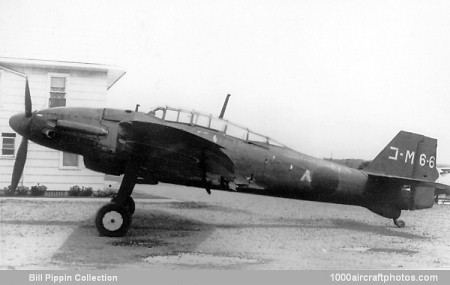In their Fourth Reinforcement Program the Japanese Navy included a request for eighteen submarines of the I-400 Class. These very large submarines, each displacing 4,500 tons, were to have a cruising radius of 41,575 nautical miles (47,844 mls, 77,000 km) at 14 kt (16 mph, 26 kmh) and were to be equipped with a large watertight hangar capable of accommodating two attack aircraft and with a catapult on the forward deck. However, the pressing need for more conventional submarines forced a revision of the plan and only five of this class were actually ordered with an enlarged hangar accommodating three aircraft.
In 1942 Aichi Kokuki K.K. at Eitoku were instructed to design a Navy Experimental 17-Shi (1942) Special Attack Bomber for use aboard the submarines of the I-400 Class. The original 17-Shi (1942) specification called for a fast catapult-launched aircraft without landing gear but this was later revised to provide for twin detachable floats. The design of the aircraft bearing the Aichi model number AM-24 was assigned to a team led by Norio Ozaki, Yasushiro Ozawa and Morishige Mori and, despite the added complexity stemming from the need to provide easy stowage in the small watertight hangar, the project progressed smoothly.
Two versions of the aircraft were designed, the M6A1 Seiran with detachable floats and intended for attack missions and the trainer version, the M6A1-K Seiran Kai, with retractable landing gear. The popular name of the M6A1-K was later changed to Nanzan (Southern Mountain).
Completed in November 1943, the first prototype M6A1 Seiran was powered by a 1,400 hp Aichi AEIP Atsuta 30 twelve-cylinder liquid-cooled inverted V-engine. The aircraft was characterized by the complicated wing and tail folding system.
The wings swiveled on their rear spar to lie flat along the fuselage, the tip of the vertical tail surfaces folded to the right and the horizontal tail surfaces folded downward. Despite the apparent complexity of the folding mechanism and the lack of space aboard the submarine, the M6A1 could be readied for flight in less than 7 min by four trained personnel. To facilitate night assembly fluorescent paint was applied to all important parts.
Seven additional prototypes powered by the Atsuta 31 engine were followed by eighteen Atsuta 32 powered M6A1 Seiran production aircraft and by two M6A1-K Nanzan with Atsuta 32 engine. The Nanzan was fitted with an inwardly-retracting landing gear, and the folding tip of the rudder was dispensed with as the absence of floats improved directional stability.
A total of 28 M6A1s were built between October 1943 and July 1945, comprizing of 8 prototypes, 18 production aircraft and 2 M6A1-K prototypes. Plans were on hand for an attack on the lock gates of the Panama Canal by the First Submarine Flotilla made up of the I-400 and I-401 submarines, each carrying three M6A1s, and of the I-13 and I-14 submarines, each carrying two Seirans. However, the target was changed to the USN's anchorage at Ulithi Atoll and the First Submarine Flotilla put to sea in late July 1945. The war ended before the attack could take place.
In the tail number Ko-M6.6, the first Japanese katakana character indicates that the aircraft was assigned to the Aviation Technical Flight Testing Station (Koku Gijitsu Hikojikenbu) at the Yokosuka Naval Air Technical Arsenal (Koku Gijutsu-sho), which the Japanese abbreviated as Kugisho. The 'M' indicates the aircraft was used for special testing purposes, the first '6' reflects the sixth special purpose aircraft produced by the Aichi, while the second '6' is an individual aircraft number.
Description: M6A1, single-engined submarine-borne attack bomber with twin detachable floats. M6A1-K, single-engined land-based combat trainer with retractable landing gear. All-metal construction with fabric covered control surfaces.
Accommodation: Crew of two in tandem enclosed cockpits.
Power plant:
M6A1 prototypes: one Aichi AE1P Atsuta 30 or Atsuta 31 twelve-cylinder liquid-cooled inverted V-engine, rated at 1,400 hp for take off, 1,250 hp at 5,580 ft (1,700 m) and 1,290 hp at 16,405 ft (5,000 m), driving a constant-speed three-blade metal propeller.
M6A1 production aircraft and M6A1-K prototypes: one Aichi Atsuta 32 twelve-cylinder liquid-cooled inverted V-engine, rated at 1,400 hp for take off, 1,340 hp at 5,580 ft (1,700 m) and 1,290 hp at 16,405 ft (5,000 m), driving a constant-speed three-blade metal propeller.
Armament: One flexible rear-firing 0.511 in (13 mm) Type 2 machine gun. Bomb-load: two 551 lb (250 kg) bombs, or one l,764 lb (800 kg) or 1,874 lb (850 kg) bomb.
The following data relate to the M6A1.
